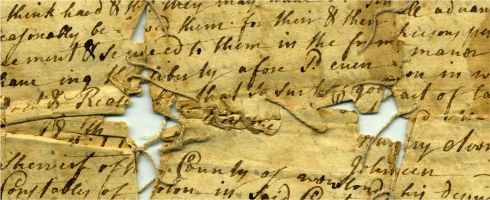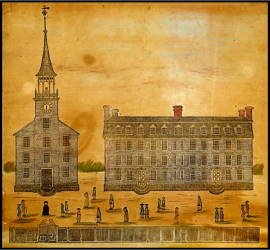The Yale Indian Papers Project has moved to the Sterling Divinity Quadrangle. After several years conducting research from Yale University’s Lewis Walpole Library in Farmington, Connecticut, the Project’s full time staff of two editors, executive editor Paul Grant-Costa and assistant executive editor Tobias Glaza, have moved into an office on the quad to bring new energy and collaborators to their “mission to advance scholarship on the history and culture of New England Native Americans.”
The project is funded by a grant from the National Endowment for the Humanities and is supported by partnerships with a number of research institutions and Native American groups. Most of the papers date from 1630s to the 1860s, and the current phase of the project covers documents starting with the earliest papers to the American Revolution. Beginning in April, the team will expand their work to the papers from the Revolution to the Civil War.
From the heart wrenching to the mundane, and from the personal to the politically significant, YIPP research has revealed details about Native American life in New England that were nearly wiped from history. The records by, for, and about the native people of New England recorded in the papers and associated documents lend great depth to otherwise lost tribal heritage for researchers and tribal members.
Paul Grant-Costa and Tobias Glaza have each been interested in Native American issues for much of their careers. Grant-Costa previously worked on international human rights issues at the Council of Europe in Strasbourg, France. Both he and Glaza have served as consultants to Native American communities seeking federal recognition and assisted tribal councils and other institutional bodies in navigating the Federal Bureau of Indian Affairs and legal processes to support sovereignty claims.
Although Grant-Costa’s work at YIPP is not directly related to sovereignty efforts, he counts the research as an extension of his human rights work. He believes that uncovering, illuminating, and giving access to the stories of families, culture and political activities and writing of a marginalized people is a work of social justice. For him, it is a human right to have access to one’s recorded documentary history. For these reasons, he is excited about the possibilities of joining the YDS community where social justice is a daily pursuit.
Grant-Costa recounts a story about a Narragansett man who heard stories in his family about enslaved natives being sent to Spain and North Africa after King Philip’s War (Metacomet’s War) as punishment. Previously scholars had dismissed the claims citing a lack of historical evidence. Through details in the papers and interdisciplinary cooperation with British Empire scholars, the team has been able to both confirm the story and provide far more information about the exiled people.
|
The YIPP digital database provides access to documents that are too fragile for public use. |
The primary goal of the project is to provide intellectual access to researchers, students, and especially native people seeking historical information. The heart of their work involves digitizing, transcribing, and annotating primary source materials into a fully accessible and searchable archive available publicly to researchers, educators, students, and Native American people. Much of the work of the project until now has been the painstaking effort to produce direct transcriptions of the documents. The original documents are now viewed as digital photographs, a significant improvement over poor-quality microfilm records, but since many of the papers are manuscripts, researchers must carefully decipher handwriting and variances of early-modern English. Once transcribed, scholarly editing produces a modern English translation that is heavily annotated by the researchers. Names, places, events, objects, and unusual expressions are all tagged with additional information, and links to related documents in the collection and documents archived by partner institutions.
YIPP covers notable missionary materials that will interest YDS researchers. As early as the 1620s, the documents reveal efforts to Christianize Indians through Indian missions. While missionaries certainly functioned as agents of colonization, their roles were complex, and documents show they sometimes acted as mediators in colonial conflicts and sometimes advocated for native people. Missionaries often provided medical assistance, food, blankets, and other supplies. Many documents show that native people used Christianizing commitments as a bargaining tool when negotiating for land rights, education, and other resources.
|
Many figures associated with Yale feature prominently in the collections missions documents, including Abraham Pierson, Ezra Stiles, Timothy Dwight, and Jonathan Edwards. |
Many missionaries to Native Americans were associated with Yale, and many buildings across the university bear their names. Among them, Jonathan Edwards was a missionary to the Stockbridge Indians, and the father of Reverend Abraham Pierson, Yale’s first rector, ministered to native people in the New Haven area.
Documents trace the traumatic political transition during the American Revolution that was devastating to native communities in New England. Under British rule, the native people were oppressed and suffered greatly as colonial subjects, yet in the British system the tribes maintained a degree of sovereignty and had access to legal systems that helped to mediate disputes with the colonists, and allowed them access to trade. However, after the revolution, native people were classified as wards of the state. Unlike children who eventually become independent, the native people were relegated to a perpetual condition with limited and imperfect access to legal systems.
When the British abandoned the colonies after the revolution, churches sprang up in many native towns that served as community centers, and the integration of Indian language, stories, and social order into Christian worship helped to preserve cultures might have otherwise collapsed under the state system. During this time, documents reveal that native people began to intermarry with Africans and freed slaves who also practiced Christianity. Tribal leaders became religious leaders and vice-versa, as religion gained cultural currency for the tribes.
|
Journal of Joseph Fish, missionary to New England Native Americans |
Missionary Joseph Fish took a documentary approach to journaling his work among Pequot and Narragansett people in several 18th-Century volumes. While his writing certainly reflects cultural biases of missionaries of the time, the text is rich with detailed descriptions of life in native communities. Taken together with other documents from the time, researchers are able to reconstruct a plausible picture of how these communities were organized.
The YIPP staff anticipate their move to the divinity school will open doors for more cross-disciplinary collaboration with religious scholars. The most exciting developments in understanding these documents have come from the diversity of voices who lend ideas for interpreting documents. In particular, among the missions documents there are theological assumptions at work that divinity scholars will help to reveal. Divinity school scholars can examine scriptural references and religious language to contextualize political and social views of the day.
In addition to the ongoing work of gathering and transcribing documents, YIPP is working on a new web interface to be unveiled later this year that will allow keyword searches across multiple collections, greatly enhancing research possibilities. In the meantime, visit the Yale Indian Papers Project on the web at http://www.library.yale.edu/yipp/index.html and read the YIPP blog at http://yipp.commons.yale.edu/.
| Attachment | Size |
|---|---|
| 3.9 KB |


